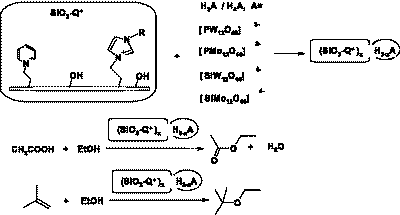I. V. Shmygol, S. A. Alekseev, O. Yu. Lavrinenko, N. S. Vasilyeva, V. N. Zaitsev, D. Barbier, V. A. Pokrovsky
Journal of Mass Spectrometry 2009, v.44, issue 8, p. 1234-1240.
Desorption/ionization on silicon (DIOS) mass spectra of model ionic dyes methylene blue(MB+Cl-) and methyl orange (Na+MO-) were studied using p+ type derived porous silicon (PS) free-layers. As-prepared PS (PS-H), the PS thermally oxidized at 300 oC (PS-OX), PS with chemically grafted cation-exchanging alkylsulfonic acid (PS-SO3H) and anion-exchanging propyl-octadecyldimethylammonium chloride (PS-ODMA+Cl-) groups were tested as ionization platforms. Two mechanisms of the MB+ desorption/ionization were proposed: i) the formation of MBH+ ion due to the reaction of MB+ with H• atoms, generated under the laser-induced decomposition of Si–H surface fragments, which is predominant for PS-H and PS-OX platforms; ii) direct thermal desorption of the MB+ cation, prevailing for PS-SO3H. The fragmentation of the molecular ion is significantly suppressed in the latter case. The samples of PS-SO3H and PSODMA+ Cl- efficiently adsorb the dyes of the opposite charge from their solutions via the ionexchange. Consequent DIOS MS studies allow to detect only low fragmented molecular ions (MB+ and MO- respectively), demonstrating the potential of the ion-exchange adsorption combined with DIOS MS for the analysis of ionic organic compounds in solutions.
Porous silicon based microdevice for reversed phase liquid chromatography
Phys. Status Solidi C, 2009 Volume 6, Issue 7 , Pages1777 - 1781
This paper deals with On-Chip-Chromatography separation systems micromachined on porous silicon. Reversed phase C18 was prepared on the porous silicon base and characterised by means of FTIR and water contact angle measurements. From this preliminary study, a liquid chromatography microdevice including silanised porous silicon layer was realized and tested for the separation of model mixture of dimethyl-and dioctyl phthalates.
Oniumsilica-immobilized-Keggin acids. Acidity and catalytic activity for ethyl tert-butyl ether synthesis and acetic acid esterification with methanol
Journal of Catalysis 263 (2009) 247–257
Keggin heteropolyacids were immobilized on functionalized silica as their onium (γ-propyl-N-pyridinium, γ-propyl-N-methyl and γ-propyl-N-butyl-imidazolium) salts. Interaction between HPA and the surface-grafted onium cations affords acid salts. In contrast to bare silica, impregnated with HPA, these materials have monoanionic dispersions of HPA on the surface and superior resistance to HPA leaching in polar media. The greatest stability of the Keggin structure and resistance to leaching were found for H4SiW12O40–(SiW)-, and the lowest for H3PMo12O40–(PMo)-based samples. In the two model reactions tested, the liquid-phase synthesis of ETBE and the esterification of AcOH with EtOH, these solids display good catalytic performance (activity per anion, up to 150 and 25 h−1, respectively) and relative high structural stability. Catalysts having a greater coverage of organic functions (revealed by comparing two pyridinium salts) and hydrophobic cations (by comparing two imidazolium salts) have the best performance. Amongst the heteropolyacids studied, H4SiW12O40 is the most active and promising for catalyst design.

T. Rozhanchuk, O. Tananaiko, I. Mazurenko, M. Etienne, A. Walcarius and V. Zaitsev
Journal of Electroanalytical Chemistry 625 (2009) 33–39
Haemoglobin (Hb) modified electrochemical devices have been prepared by Hb encapsulation in silica sol-gel films (SiO2) generated by electrodeposition onto pyrolitic graphite electrodes (PGEs). The stability and electrocatalytic activity of Hb entrapped into SiO2 network was substantially enhanced in the presence of cationic surfactant (CTAB) and Au nanoparticles (Au-NPs). The composition of sol-gel synthesis medium, i.e., molar ratio of silica precursor to water, contents of Hb, CTAB and Au-NPs, as well as the conditions of electrodeposition had a great influence on the electrocatalytic activity of Hb on PGE surface. The electrochemical response of the PGE modified with the composite SiO2–Hb–CTAB–Au-NPs film was found to vary linearly with the concentration of dissolved oxygen in solution and this was exploited to determine this analyte in the tap water with detection limit 0.12 mg·L-1. The electrocatalytic current of dissolved oxygen was also found to decrease in the presence of the antivirus drug – amino derivative of adamantane (rimantadine) –, which opens the way to the determination of this drug with detection limit 0.3 mg·L-1 using PGE modified with SiO2–Hb–CTAB–Au-NPs nanocomposite film.
Журн. аналит. химии, 2009 2009, т. 64, № 2, с. 124–129 (Journal of Analytical Chemistry, 2009, Vol. 64, No. 2, pp. 110–115)
Изучена возможность применения кремнезема с привитыми группами полиоксиэтилированного изооктилфенола (SiO2-TX) в качестве адсорбента для твердофазно-экстракционного концентрирования пестицидов на основе хлорфеноксиалканкарбоновых кислот из водных сред. Показано, что в интервале рН=8-10, на SiO2-TX наблюдается эффективное (до 96%) извлечение
2,4-дихлорфеноксиуксусной кислоты (2,4-Д) в виде ионного ассоциата с цетилтриметиламмонийбромидом (ЦТАBr). Оптимальный мольный избыток ЦТАBr к 2,4-Д составляет 200:1. Емкость SiO2-TX по 2,4-Д в области Генри составляет 0.42 мг/г адсорбента, а коэффициенты распределения 2,4-Д достигают значений 9×102 мл/г. Показано, что аналит количественно элюируется 1-2 мл ацетонитрила, что позволяет использовать адсорбент в качестве патрона для твердофазной экстракции перед стадией анализа пестицидов методом ВЭЖХ. Возможно повторное применение SiO2-TX после кондиционирования патрона. Методика концентрирования позволяет извлекать микроколичества пестицидов из водных растворов, вплоть до 0,025 мг/л.
Silica with immobilized polyethoxylated isooctylphenol groups (SiO2-TX)is studied as an adsorbent for the solid-phase extraction preconcentration of pesticides based on chlorophenoxyalkanecarboxylic acids from aqueous solutions. It is demonstrated that 2,4-dichlorophenoxyacetic acid (2,4-D) is efficiently (up to 96%) extracted as an ion associate with cetyltrimethylammonium bromide (CTMAB) with SiO2-TX in the pH range 8–10. The optimum CTMAB-to-2,4-D molar ratio is 200 : 1. The capacity of SiO2-TX to 2,4-D in the Henry region is 0.42 mg/g of adsorbent, and the distribution coefficients reach 9*102mL/g. It is shown that 2,4-D is quantitatively eluted with 1–2 mL of acetonitrile, which allowed us to use the adsorbent in a preconcentration cartridge before determining pesticides by HPLC. The procedure allowed pesticides to be recovered from aqueous solutions in concentrations beginning from 0.025 mg/L.
Н.Є. Писарева, М.Ф.Зуй, Є.О. Писарев, В.М.Зайцев
Укр. хим. журн. 2009 №1, с.58-62.
Показана можливість застосування мікрохвильової пробопідготовки для кислотного розкладання харчових продуктів при визначенні йоду в зразках кінетичним методом, за реакцією Сендела-Кольтгофа. Показано, що вплив нітратної кислоти можна нівелювати введенням в систему сульфамінової кислоти. Запропонований метод дозволяє визначати загальний вміст йоду у розчинах на рівні 20 мкг І/дм3 та 1 мкг І/г харчового продукту. Визначенню не заважають іони купруму (до 50 мг/дм3) та феруму (до 100 мг/дм3) відповідно.
Трохименко О. М.,Зайцев В. М.
МЕТОДЫ И ОБЪЕКТЫ ХИМИЧЕСКОГО АНАЛИЗА 2009, Том 4, № 1, c. 4-10.
Здійснено наукометричне дослідження публікацій за останні три десятиріччя з аналітичної хімії йоду.Наукометричні дані представлено у поділі за роками, способами пробопідготовки, методами й об'єктамианалізу та формами йоду, що визначуються. Зроблено висновки про тенденції, що спостерігаються з часому світовій науковій літературі у цій царині.
Trokhymenko O.M., Zaitzev V.N. Scientometrics investigations the published works for last three decades in methods the determination of different forms iodine in objects – It was realize scientometrics investigation published works last three decades in analytical chemistry of iodine. Scientometrics information was present in division into years, procedure the preparation of probe, methods and objects of analysis and determinated forms of iodine. It was made too conclusion to a tendency observed in time in this field.
Зайцев В. М., Зуй М.Ф., Сливчук Л. А., Герда В. І.
МЕТОДЫ И ОБЪЕКТЫ ХИМИЧЕСКОГО АНАЛИЗА 2009, Том 4, № 1, c. 28-33.
Запропонований новий аніоніт октадецилдиметиламіно-g-пропілкремнезем (SiO2-ЧАС) для сорбційного концентрування мікрокількостей бромід- та бромат-іонів. Властивості SiO2-ЧАС по відношенню до бромід- та бромат-іонів порівняні з властивостями комерційного аніоніту АВ-17. Запропонована методика концентрування бромат-іонів на SiO2-ЧАС з наступним елююванням та спектрофотометричним визначенням BrO3- перевірена при аналізі водопровідної води методом введено-знайдено. Метод дозволяє визначати бромат-іони із чутливістю 1,0·10-6 моль/л при Sr £ 0,2.
Zaitsev V.M., Zuy M.F., Slivchuk L.A., Gerda V.I. Sorption of microquantities of bromate- and bromide-ions on AV-17 and octadecyldimethyl-g-aminopropylsilica gel anionites – New anionite octadecyldimethyl-g-aminopropylsilica gel (SiO2-QAS) has been proposed for sorption preconcentration of microquantities of bromate- and bromide-ions. Properties of SiO2-QAS concerning BrO3-- and Br-- ions have been compared with the properties of commercial anionite AV-17. New method for determination of BrO3- has been developed using SiO2-QAS and it has been checked on analysis of tap water by standard addition method.
Халаф В. А., Турчин В. О., Зайцев В. Н.
МЕТОДЫ И ОБЪЕКТЫ ХИМИЧЕСКОГО АНАЛИЗА 2009, Том 4, № 1, c. 67-73.
Изучена возможность применения нового метода твердофазной экстракции (ТФЭ) для концентрирования 2,4-дихлорфеноксиуксусной кислоты (2,4-Д) из водных объектов окружающей среды с последующим разделением и определением методом высокоэффективной жидкостной хроматографии (ВЭЖХ) с УФ-детектированием. Как адсорбент для ТФЭ предложен кремнезем с привитыми группами полиоксиэтилированного изооктилфенола (SiO2-TX). Установлено, что в оптимальных условиях извлечения 2,4-Д на SiO2-TX (pH = 8,8; n = 1,5 мл/мин; мольному избытку цетилтриметиламмоний бромида к 2,4-Д 200:1) и коэффициенте концентрирования 50, предел обнаружения 2,4-Д составляет 0,07 мкг/мл (0,33 мкмоль/л) в линейном диапазоне от 0,09 до 0,20 мкг/мл (от 0,45 до 0,91 мкмоль/л).
Khalaf V.A., Turchin V.O., Zaitsev V.N. Determination of 2,4 dichlorophenoxy acetic acid in aqueous environmental samples – The present study describes the application of new solid phase extraction (SPE) techniques for the pre-concentration of 2,4-dichlorophenoxyacetic acid (2,4-D) in the aqueous environment with following separation and quantification by high performance liquid chromatography with an ultraviolet detector. Silica with immobilized polyoxyethylated isooctylphenol (SiO2-TX) was used as an adsorbent for SPE of chlorophenoxy acid pesticides. Under optimum recovery conditions of 2,4-D (pH = 8,8; n = 1,5 ml/min; molar excess of cetyltrimethylammonium bromide to 2,4-D is 200:1) and concentration factor 50 the detection limit of 2,4-D was 0,07 g/mL (0,33 µmol/L) with linear concentration range from 0,09 to 0,20 g/mL (from 0,45 to 0,91 µmol/L).
Л.С. Костенко, В.М.Зайцев
Укр. хим. журн., 2009. т.75, №10, P. 83-90.
Запропоновано схему одержання та з’ясовано оптимальні умови синтезу силікагелю функціоналізованого похідним амінофосфонової кислоти - 1-пропіламіно-1(2-гідроксибензил)-метанфосфоновою кислотою (SiО2-ОБФК). Функціональний склад поверхневого шару доведено методами FTІR, 31Р ЯMР-спектроскопії та термічного аналізу: термогравиметрії, диференційної скануючої калориметрії та мас-спектрометрії з термопрограмованою десорбцією. З даних елементного аналізу встановлено, що запропонований підхід дозволяє отримати адсорбент, поверхня якого містить до 78% іммобілізованих похідних амінофосфонової кислоти. Проведено порівняльний аналіз адсорбційних властивостей SiО2-ОБФК та деяких інших функціоналізованих силікагелів по відношенню до іонів міді (II), свинцю(II) та кадмію (II).
